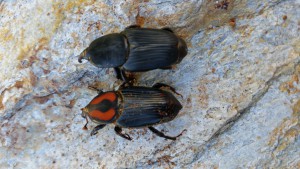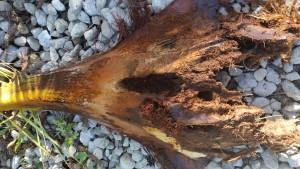
Anyone who has had a treasured palm tree annihilated by palmetto weevils (Rhynchophorus cruentatus) knows the pain of losing a long-lived tree from the home landscape. These large, native weevils are adept at working unnoticed inside a palm to the point of terminal damage. Typically, by the time you notice that the tree is declining and fronds begin to turn brown there is likely no hope of salvaging the situation. By then the larval grubs have already damaged the tree’s growing bud to the point of no return. At this stage the recommended procedure involves removing the tree, cutting it up and burning it to prevent the invading long-snouted critters from moving over to neighboring palms.
However, as frustrating as this is, if we step back and look at the bigger picture it is apparent that even our most aggravating native insect pests are part of the natural web of life and local plants have adapted to survive these “give and take” relationships on the population scale.
Palmetto weevils establish in a new tree when adult females lay their eggs in the crown of the tree and larvae hatch to burrow into the soft terminal bud. It is larval feeding that does the lethal damage. Larvae are large, white, legless grubs that can reach lengths of six-seven centimeters. When larvae are mature they create a cocoon inside the tree from tree fibers and pupate there before hatching into adults to start the cycle over. Grubs can be found in any part of the tree but really need the softer, growing parts for food, such as in the base of the living fronds and the terminal bud.
The condition created by these burrowers is often referred to as “popped neck,” where the top of a palm tree dies and caves over. If you are in the process of removing a dying or dead palm due to the crown dying it would be a good idea cut through the top section with a chainsaw to see if weevil damage is evident in large (about ½ inch) diameter tunnels. If a live specimen of an adult can be captured in a jar it would be worth a visit to your local Extension office for a positive identification to make sure you aren’t dealing with another similar species of non-native weevil that has not been documented in Florida yet. The red palm weevil (Rhynchophorus ferrugineus) has now been found in the U.S. at Laguna Beach, California. Coloration varies by individual bug but a positive i.d. can be obtained by sending the specimen to UF’s laboratory in Gainesville. For further information on palmetto weevils refer to the EDIS fact sheet at this web link.
Posted: October 8, 2015
Category: HOME LANDSCAPES, Pests & Disease
Tags: Arrgh, Palmetto, Panhandle Outdoors, Weevils



